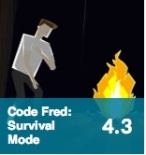tomasandersen44blog
"Never before had a contest held so much promise – or so much danger." 39 Clues: One False Note
What Components Do Serious Games Have in Common?
Many of my personal feelings of what a game needs to be a Serious Game coincide with what I have found online, as well as what many people involved with the course have stated. Even if some of us describe or word our desires differently, the end game, so to speak, is the similar.
For instance:
The game must have an outcome; this meaning the game cannot simply end like a bad movie sequel. I have seen this in many of the Gizmos or labs, found at Explore Learning. Just today I had my class go to Explore Learning, and play the Food Chain gizmo. The goal was to find out how to have an ecosystem in equilibrium or not in equilibrium. There are many variables that include health and population changes involving grass, rabbits, snakes, and hawks. The students discover that meddling with the populations have some short term, and long term changes across the links in the food chain. If a “score” is needed students can take a quiz to show how they faired in their learning, but the student worksheet/guide is more than enough for myself to express what they learned. This is only one possible version of an outcome. Outcomes can also be simply coming away from the game having more insight into a person, people, or situation.
The game must have a quick learning curve. Most of the games I have played (such as medical games at Games for Change) have a brief introduction, and then the ability to jump right in and play the game. Most nuances can be picked up along the way, or are explained before playing. Any practice that takes more than a few minutes to learn will be a wasted attempt at “quick lessons” or require more than a few class periods to play, which in most cases is not possible. Even many Explore Learning gizmos require two periods to complete, with help, which in my experience has scared off many other instructors I have worked with.
The game must be void of unnecessary elements. This could include anything that takes away from or distracts from the main focus of the intent for the game. In examples I gave in my previous Friday Blog I stated that many game developers for Serious Games ask that the educational components be integrated rather than blatantly placed as obstacles. For example in an adventure game the gamer is required to solve a math problem to continue on the non-mathematical quest, but instead is required to solve logic puzzles or riddles involving math and science that has been integrated into the story line. One such game that does a good job is Death in Sakkara. Play this game at your own risk, and be warned, you will be in front of your computer at risky times during your work day.
Another unnecessary element that everyone agreed on was random violence that did not support the story line. If the story line was about Civil Rights, or a War some violence would be part of the story, but if the game presented itself along the lines of Grand Theft Auto then the game is more of an entertainment video game than a Serious Game.
One of the last great ideas I liked was the game should enhance or instill some sort of skill or desire to make the world more than it is. If the user learns that the world is a delicate balance of creatures and ecosystems then the user has a new skill set to make a difference in the world, even if it is just the knowledge. The user may be inspired to make major changes for race or gender, or even assist in advancements in the sciences.
#etlead





Man, I really enjoy reading your blog! I always come away with something I want to explore more or play with. Except for Twitter. Twitter still ticks me off.
Your posts remind me of Salieri’s comments about Mozart in the movie “Amadeus”. “His work has the perfect amount of notes, not too many or too few. It is perfection.” You hit all the notes without overdoing it. Now I have to go play Death in Sakkara.
Tomas,
Great job with the components. I agree with all of them. I particularly like how you explained unnecessary violence. Some may add to certain story lines, and only then should be in the game. And like Chris above, I am going to have to check out Death in Sakkara. I’ve always wanted to check out these kind of games, but have never taken the time. Who knew I would get the chance in a class?